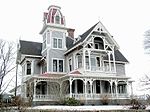Money Island (Branford, Connecticut)
Branford, ConnecticutConnecticut geography stubsLandforms of Middlesex County, ConnecticutLong Island SoundThimble Islands

Money Island is one of the Thimble Islands off Stony Creek, a section of Branford, Connecticut. It is named after a legend that Captain Kidd buried his treasure there. The island, 12 acres (49,000 m2) in size, bears an entire village of 32 houses, a post office, and one library. Former buildings included a school, a church, and a grocery store. There are three roads and several piers. At this time, none of the houses are occupied year-round.The three roads are Montowese Avenue, Pequot Avenue, and Kidd's Lane.
Excerpt from the Wikipedia article Money Island (Branford, Connecticut) (License: CC BY-SA 3.0, Authors, Images).Money Island (Branford, Connecticut)
Montowese Avenue,
Geographical coordinates (GPS) Address Nearby Places Show on map
Geographical coordinates (GPS)
| Latitude | Longitude |
|---|---|
| N 41.24955 ° | E -72.75164 ° |
Address
Montowese Avenue 98
06405
Connecticut, United States
Open on Google Maps



